Is anybody sick of artifacts yet? Aether Revolt is still fresh but this week's Trinkets & Tools is going to be shifting gears and talking about enchantments (a cycle of five to be exact), all five Siege enchantments from Fate Reforged! This article is going to be moving a little bit quicker than usual so I can cover everything, so let's jump right in!
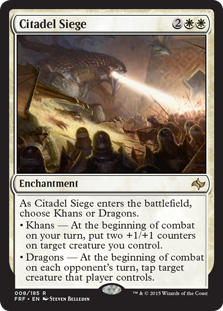
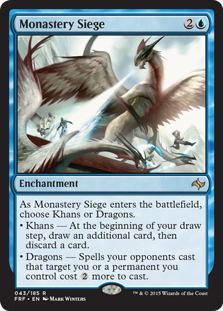
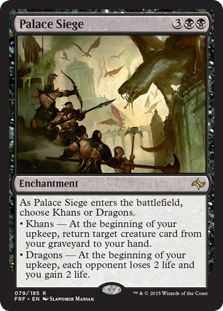
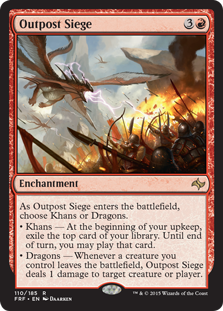
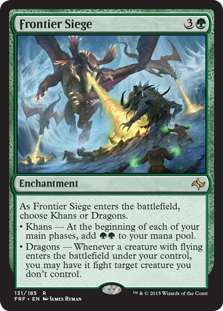
Khans or Dragons?
The sieges are a cycle of rare enchantments from Fate Reforged that all ask the same question as they enter the battlefield: Khans or Dragons? Depending on your choice, the enchantment will have one of two entirely different effects. This is essence makes the sieges comparable to modal spells like Kolaghan's CommandKolaghan's Command or Mystic ConfluenceMystic Confluence, but with a permanent effect.
So what kinds of decks utilize the sieges the best? Ideally, a good fit can make use of both effects for increased flexibility, but many decks plan on playing these enchantments on a single mode 90% of the time, with the other option as a backup. Still, decks do exist that can capitalize on both halves of the siege profitably, and I'll mention those as we analyze each card.

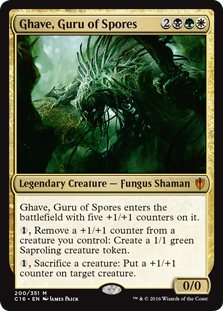
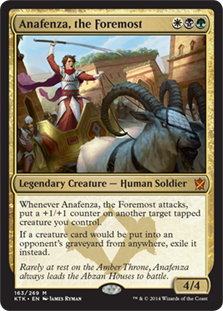
Citadel Siege
Going in proper WUBRG order, we start with the least popular part of the cycle, the white Citadel SiegeCitadel Siege. Some readers may object to this claim, as Citadel Siege shows up in the second largest number of decks out of this whole cycle according to EDHREC at approximately 2,100 decks. However, if you look closer, you'll notice that over 550 of these entries are for Commander 2016 all-star Atraxa, Praetors' VoiceAtraxa, Praetors' Voice, where Citadel Siege was reprinted in that deck. Now I'm not saying Citadel Siege is the worst card ever for this deck, but when you consider that Atraxa herself is able to put a +1/+1 counter on an entire army of creatures, the siege's ability to only place two looks fairly weak. As such, it seems likely that most Atraxa decks with Citadel Siege just haven't cut it yet, and when you discount even half of those, Citadel Siege falls to dead last.
Still, the card definitely has some uses. Khans Mode as previously mentioned places two +1/+1 counters on a single creature you control, making this an potential inclusion in any +1/+1 counter deck. It pairs nicely with other +1/+1 counter placers like Cathars' CrusadeCathars' Crusade, as well as commanders that can use those counters for purposes other than attacking like Ghave, Guru of SporesGhave, Guru of Spores, Marath, Will of the WildMarath, Will of the Wild, or Mikaeus, the LunarchMikaeus, the Lunarch. Outside of commanders, having Citadel Siege alongside creatures like Crystalline CrawlerCrystalline Crawler, Champion of LambholtChampion of Lambholt, or Hangarback WalkerHangarback Walker can also be a good strategy to get the most out of those two counters each turn.
Dragons mode of Citadel Siege gives you the ability to lock down one of your opponent's creatures on each of their turns. This is extremely useful against voltron decks that try to win through attacking with a single creature, or it can be played offensively to help tap down potential blockers. These more broad uses probably do not merit Citadel Siege's inclusion is any deck on their own (unless you're having a big issue with voltron in your meta), however the circumstances in which Dragons mode is useful do come up. As such, I believe the best home for Citadel Siege is in an aggressive +1/+1 counters deck, such as the number two most frequent user of the card on EDHREC, Anafenza, the ForemostAnafenza, the Foremost. There, Citadel Siege can be used to it's fullest potential, pumping up creatures and quickly turning Abzan FalconerAbzan Falconer or Elite ScaleguardElite Scaleguard into lethal finishers, while additionally helping to clear the way for attacks in situations where you already have enough +1/+1 counter production.

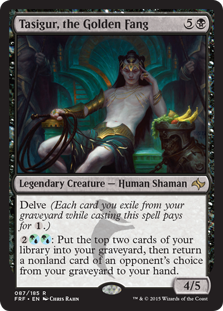
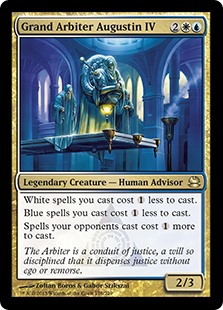
Monastery Siege
Next in the cycle we have the blue Monastery SiegeMonastery Siege. It's the least mana intensive of the cycle at 2U, but also the least played, at just under 2,000 entries at the time of writing. Blue is not traditionally known for its enchantments aside from a few mainstays such as Rhystic StudyRhystic Study, but Monastery Siege is definitely one of the most interesting ones out there, offering a choice between one common effect or a less typical one.
If you choose Khans mode, Monastery Siege allows you to "loot" (or draw a card and discard a card) once each draw step. It's notable that this wording lets you draw your second card at the same time as your normal draw, so unlike an upkeep trigger, you get to see both draws before deciding what to toss. Discarding isn't always a bad thing though, and it is for this reason that Monastery Siege's most frequent user is none other than Tasigur, The Golden FangTasigur, The Golden Fang. Looting effects are great in Tasigur because they help make him cheaper to cast by providing delve fuel. And thanks to Tasigur's own activated ability, the cards are easy enough to get back into your hand. On top of that, some Tasigur builds opt for a reanimator theme, in which filling the graveyard becomes an important part of the deck's strategy. Tasigur isn't alone in this role; other commanders that appreciate a loot each turn include The MimeoplasmThe Mimeoplasm, Sidisi, Brood TyrantSidisi, Brood Tyrant, and strangely absent from Monastery Siege's EDHREC page, Gisa and GeralfGisa and Geralf
If looting isn't your thing, Dragons mode offers you and permanents you control protection from your opponent's single target spells. This can be good if you're trying to disincentivize your opponents from removing your stuff or pointing spells at you, and Monastery Siege even protects itself! As such, this mode is a great option if you're playing one of the previously mentioned commanders and your graveyard is already full enough or your hand is too big. Alternatively, this mode can be the primary one in a deck focused on taxing your opponent's mana alongside cards like PropagandaPropaganda or Sphere of SafetySphere of Safety. No commander does this better than Grand Arbiter Augustin IVGrand Arbiter Augustin IV, a very powerful stax commander. Suddenly your opponents have to play an extra three mana if they even want to target something belonging to you, and on top of that you still can try to answer with a counterspell. Plus, if you run low on quality cards, you can always just use Khans mode for some additional card selection.

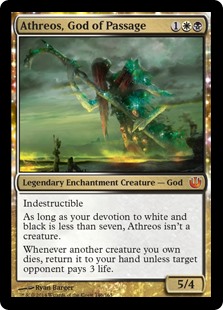
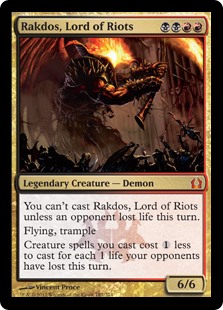
Palace Siege
Holding the crown as the most commonly used part of the cycle, Palace SiegePalace Siege is played in over 3,000 decks according to EDHREC. It has two effects that are very integral to the strategies of certain commanders, and the Khans mode specifically was well liked enough that the newly released partner, Ravos, SoultenderRavos, Soultender, has the ability himself!
Khans mode lets you grab a creature from your graveyard and put it in your hand each upkeep, an effect very useful for graveyard themed decks. When combined with a card that sacrifices itself as part of its effect such as Fleshbag MarauderFleshbag Marauder or an evoke creature like ShriekmawShriekmaw, you gain the ability to use that effect every turn provided you have the mana available. Commanders such as Jarad, Golgari Lich LordJarad, Golgari Lich Lord, Karador, Ghost ChieftainKarador, Ghost Chieftain, or Meren of Clan Nel TothMeren of Clan Nel Toth all can find plenty of uses for this effect, however my personal favorite is Athreos, God of PassageAthreos, God of Passage. Athreos gives your opponents a choice between letting your dead creatures stay dead at the cost of three life, or letting you put them back into your hand. But when Palace Siege becomes part of the equation, suddenly your opponents are only deciding if you can take back the creature now or at your next upkeep, making it easy for you to pull ahead with sheer card advantage.
Palace Siege's Dragons mode has the fairly straightforward effect of draining each of your opponent's life totals by two every turn, while giving you two life in return. The effect seems small, but it is actually the main reason Palace Siege is such a widely used card, as evidenced by the commanders it is most commonly played with. First we have a commander that take advantage of life being lost by your opponents, Rakdos, Lord of RiotsRakdos, Lord of Riots. Rakdos is a unique commander in that he can only be cast if an opponent lost life that turn, but Palace Siege provides a repeatable source of life loss that is hard to prevent. On top of that, he reduces the cost of spells equal to how much life your opponents have lost on that turn. So in a four player commander game, one upkeep trigger of Palace Siege reduces the cost of all of your spells by a whooping six mana, turning huge demons, dragons, and eldrazi into very low costed threats. But there are also many commanders suited to take advantage of the two life that you gain each turn, the most notable of which is Karlov of the Ghost CouncilKarlov of the Ghost Council. Karlov specifically wants as many lifegain triggers as possible in order to give him lots of +1/+1 counters, and Palace Siege provides one each turn. If you're interested in doubling up, combining Dragons mode with Exquisite BloodExquisite Blood gives you a second trigger, while cushioning your life total a sizable amount as well.

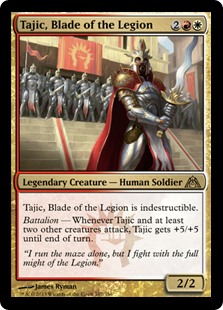
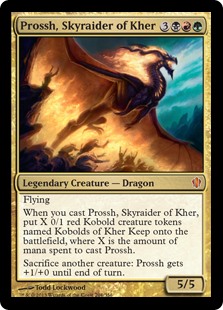
Outpost Siege
We're not finished yet! Outpost SiegeOutpost Siege is next on our list as the second (or third if we're counting Citadel Siege) most commonly used siege at over 2,000 entries on EDHREC. This one's my personal favorite in the cycle, and it even saw some Standard play in sideboards when it was first released!
Outpost Siege's Khans mode is an effect that red doesn't get very often; card draw. Sure its not "technically" card draw, as the extra card you are drawing is exiled face up and must be played that turn, but playing a land is never a challenge and red as a color has a tendency to play a lot more proactive cards than reactive ones. That being said, this effect is not for Izzet players trying to draw into more counterspells, but for color combinations like Boros and mono red, where card advantage is much harder to come by. There aren't any specific commanders that need this effects more than others, but any aggressive, low curve red decks such as Tajic, Blade of the LegionTajic, Blade of the Legion will certainly appreciate it.
With the premise that most decks running Outpost Siege will appreciate the card advantage half, the best decks for it will be the ones that can take advantage of the Dragons mode as well. This mode deals one damage to creature or player every time a creature you control leaves the battlefield. This wording was probably chosen because of the raid mechanic introduced in Fate Reforged, but it means that a deck with lots of creatures, such as Krenko, Mob BossKrenko, Mob Boss or Prossh, Skyraider of KherProssh, Skyraider of Kher (who both run this siege very often), can dish out a ton of damage in response to any kind of board wipe, even ones that don't actually kill your creatures like Cyclonic RiftCyclonic Rift. While this effect can certainly be used in a defensive manner, another option is to sacrifice your creatures. Red and black in particular give you plenty of options, my favorite of which is Goblin BombardmentGoblin Bombardment because you get to deal twice as much damage. And as long as you're flooding the board, consider pairing Outpost Siege with something like Impact TremorsImpact Tremors so your creatures can deal damage on the way in and on the way out.

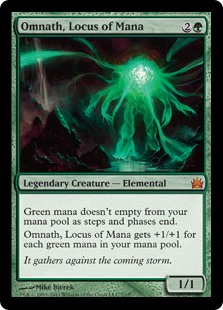
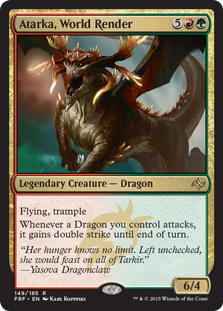
Frontier Siege
Finally, we end on Frontier SiegeFrontier Siege, the green member of the cycle with about 100 less decks than Outpost SiegeOutpost Siege on EDHREC. This siege stands out as having one effect that is very in-color, and one that seems a little out of place in green decks. Thankfully, with EDH being as big of a format as it is, Frontier Siege has plenty of applications in our format.
Khans mode is a strange sort of mana ramp ability, giving you two green mana to work with in each of your main phases. So overall, you're getting an extra 4 mana to work with each turn, however the mana has to be split up, and can't be played in combat or on your opponent's turns. Still, 4 mana is nothing to scoff at, especially if you find a way to save it for later. Gemstone ArrayGemstone Array provides one way to save the mana, and you can even spend it as different colors. But a far more efficient way of saving it would be run one of two mana-saving commanders, Omnath, Locus of ManaOmnath, Locus of Mana and Kruphix, God of HorizonsKruphix, God of Horizons. Both of these commanders give you something to do with unspent mana, allowing you to save it for big creatures and/or X spells later in the game. Omnath in particular stands out as the commander who plays Frontier Siege the most, likely due to Omnath's ability to hang onto green mana specifically.
Frontier Siege's more aggressive option is Dragons mode, which lets any creature you play with flying immediately fight a creature you don't control. Now green itself isn't well known for it's fliers, but just about every other color has at least something that can take advantage of this ability, be it a sphinx in blue, a demon in black, or an angel in white. One option that every color has options for, especially red, is dragons, and dragons also work quite nicely with the enchantment Dragon TempestDragon Tempest. When both of these enchantment in play, your dragons will not only enter the battlefield with haste, but also with the ability to take two creatures down immediately. Two commanders that help set this option up are Atarka, World RenderAtarka, World Render and Scion of the Ur-DragonScion of the Ur-Dragon. On top the this application, both of these commanders need to ramp a ton too, making Frontier Siege's first ability applicable with them as well.
Conclusion
That's all for this week's article about the siege cycle, some powerful enchantments with a ton of applications in EDH. Has this article encouraged you to try running one of the sieges in your own decks? Which of the cycle do you like the most? As always I'm available on Twitter @DomSaccento.
Dom Saccento
Dom is a Magic player from Northern New Jersey. His favorite formats are Commander and Draft. When he's not playing or reading about Magic he can be found concert-going or cooking.
Your opinions are welcome. We love hearing what you think about Magic! We ask that you are always respectful when commenting. Please keep in mind how your comments could be interpreted by others. Personal attacks on our writers or other commenters will not be tolerated. Your comments may be removed if your language could be interpreted as aggressive or disrespectful. You may also be banned from writing further comments.
